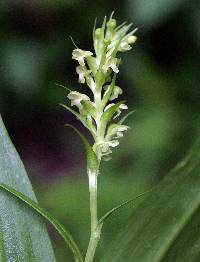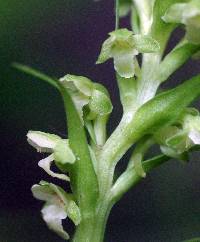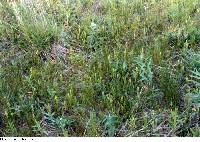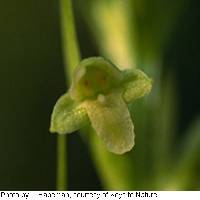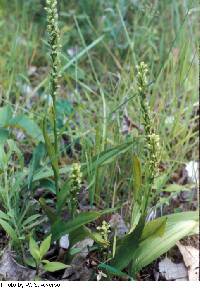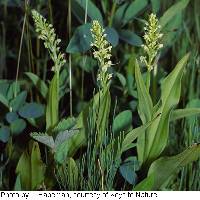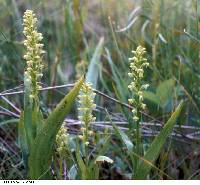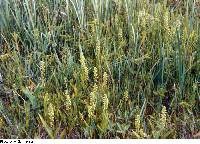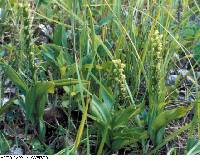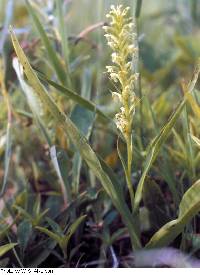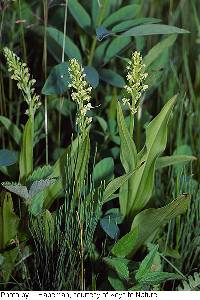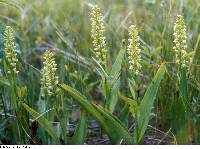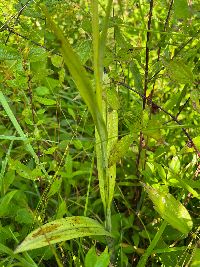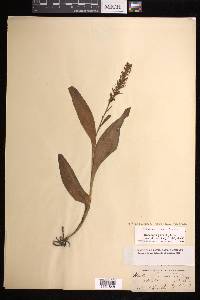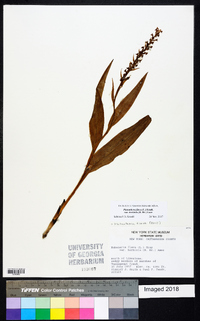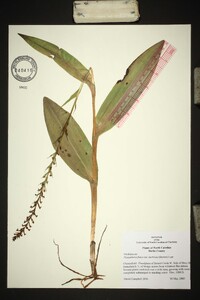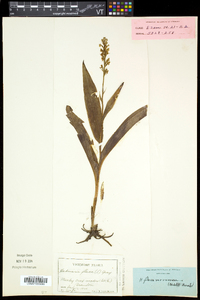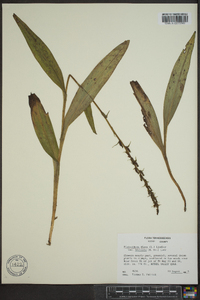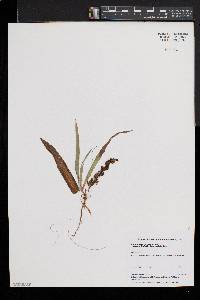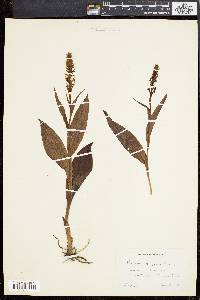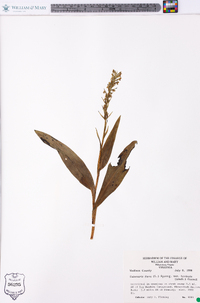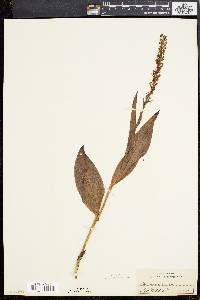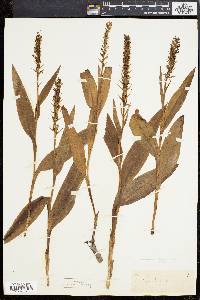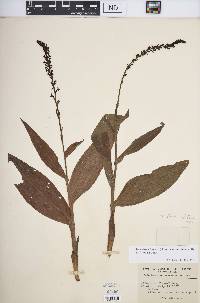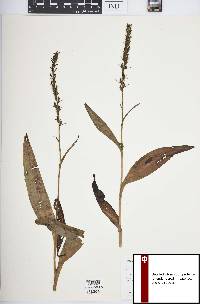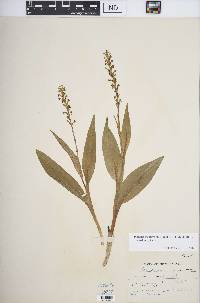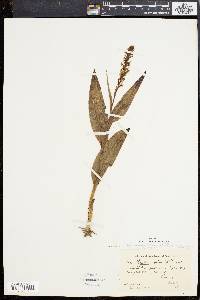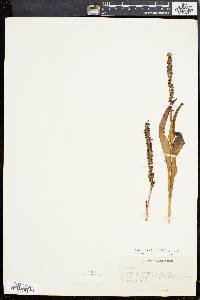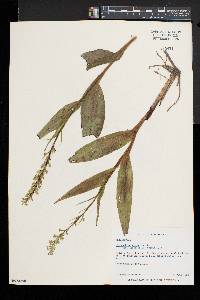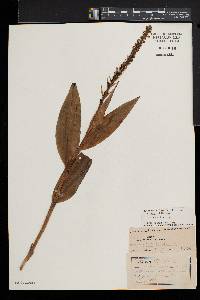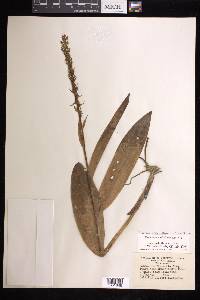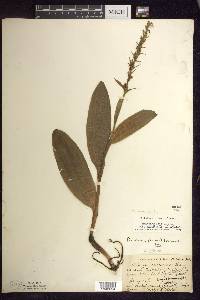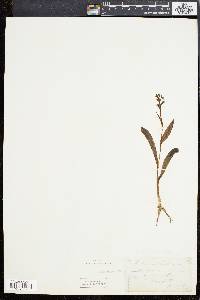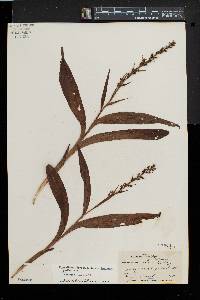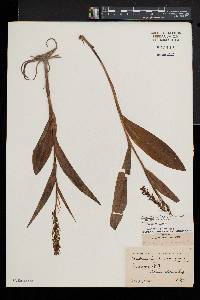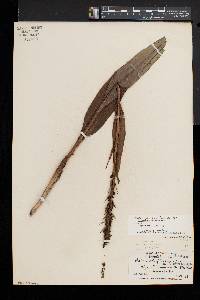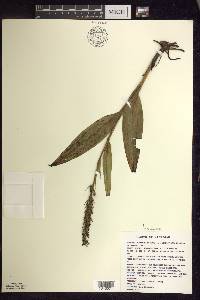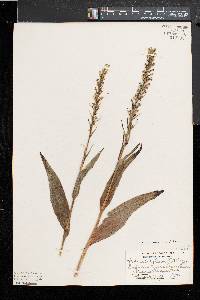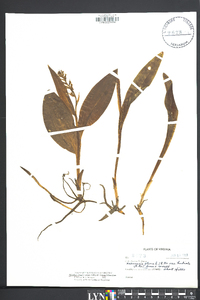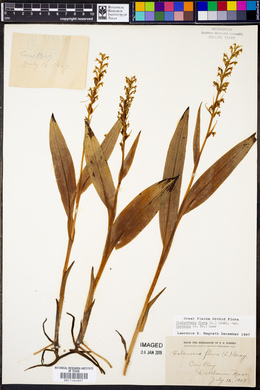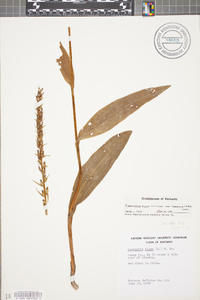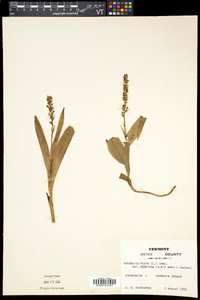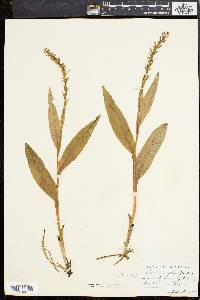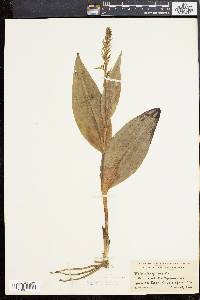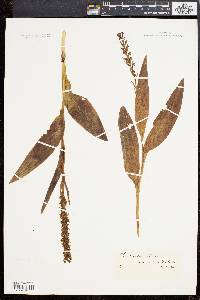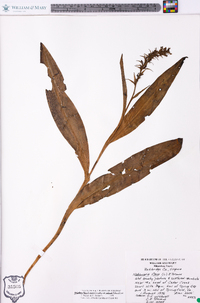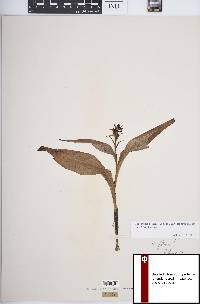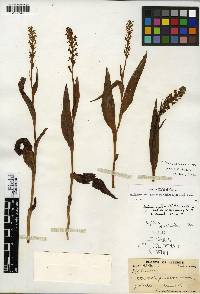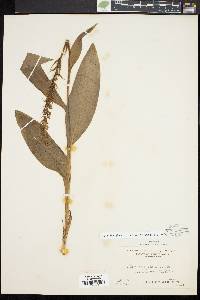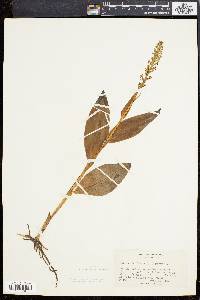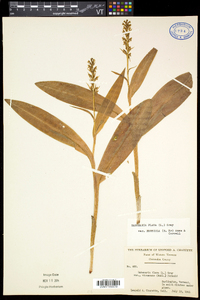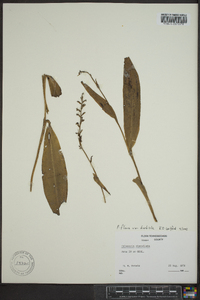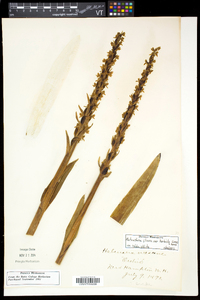
|
|
|
|
Family: Orchidaceae
Pale-Green Orchid
[Habenaria flava var. herbiola (R. Br.) Ames & Correll] |
Inflorescences rather dense, stout (in part from floral bracts usually long, often greatly exceeding flowers); lip (excluding auricles) oblong, obtuse or rarely emarginate, rarely triangular and acute. 2n = 42. Flowering May--Aug. Alluvial forests, riparian thickets, wet meadows, wet prairies, seeps, salt marshes; 0--900 m; N.B., N.S., Ont., Que.; Ark., Conn., Del., Ill., Ind., Iowa, Ky., Maine, Md., Mass., Mich., Minn., Mo., N.H., N.J., N.Y., N.C., Ohio, Pa., R.I., Tex., Vt., Va., W.Va., Wis. Tuberoids and the over-wintering bud typically form at a marked distance from the parent shoot, resulting in clonal colonies dominated by sterile plants. The southern Platanthera flava var. flava and the northern var. herbiola are very distinct in their extreme forms, but they seem to intergrade, at least in the herbarium. They are usually as readily distinguished by plant habit as by lip shape. The slender, laxly flowered habit of the former is compounded by usually short floral bracts, whereas in the latter bracts are typically longer than the flowers and often exceed them, adding to the congested and broader aspect of the inflorescence. Further complicating determination are a few specimens from the region from the southern tip of Lake Michigan south and southwestward. Those have markedly triangular lips with prominent triangular auricles or basal lobes. These stout but rather laxly flowered plants seem to occupy mesic wooded slopes and may constitute a distinct taxon; comparisons should be made with similar Asiatic species.
Perennial herb 13 - 65 cm tall Stem: single, erect, slender, green, hairless, leafy with at least two lowest leaves large and wide, with gradual or abrupt reduction in size upwards into narrower bract-like leaves. Leaves: two to four, alternate, stalkless (base slightly sheathing), spreading to ascending, non-toothed, hairless, shiny, yellow-green, with lowest two or three larger (5 - 35 cm long, 1 - 7 cm wide), oblong-elliptic to lance-shaped, and upper one or two smaller, narrower and bract-like. Inflorescence: a single, erect, terminal, hairless, dense, elongate, spike-like cluster of ten to forty, almost stalkless flowers with each flower subtended by a 1 - 1.5 cm long, about 2 mm wide, lance-shaped, non-toothed, hairless bract. The lower bracts are longer than the flowers, but the uppermost are shorter and may be only as long as the flowers. Flowers: very short-talked, yellowish green, not showy, small, hairless, bilaterally symmetric with spreading lateral sepals, and center sepal and lateral petals closely positioned above the blunt lip petal, which has base modified into a nectar spur. The reproductive parts of stamens, stigma and style are fused into a column above the 0.8 - 1 cm long inferior ovary. Sepals: three, petal-like, greenish, hairless, non-toothed, 2 - 3 mm long, 1 - 2 mm wide, widely egg-shaped to almost round. The two lateral sepals spread outwards on either side of the lip petal, while the central, uppermost sepal is positioned very closely to the lateral petals, which together extend forward to form a hood over the column. Fruit: several, fairly stalkless, tightly erect, ellipsoid, hairless capsules with remnant floral parts at apex, and subtended by more or less spreading bracts. Roots: fleshy, very long, colony-forming, and giving rise to new plants. Lateral petals: two, greenish yellow, fleshy, extended forward and curved inward, flanking central sepal, hairless, non-toothed, 2 - 5 mm long, 1 - 4 mm wide, oblong to rounded with tips somewhat wavy-edged. The lateral petals and central sepal form an arching hood over the column and lip. Lip petal: one, central, lowermost, curved downward, greenish, fleshy, hairless, 2 - 6 mm long, 1 - 5 mm wide, longer than wide, oblong to egg-shaped, base with pair of outward-projecting teeth or bumps on side, a nose-like bump midway near where bends downward, and rounded, usually non-toothed tip (sometimes slightly wavy). The base of the lip petal is modified into a backward projecting, 4 - 8 mm long, green, club-shaped or slenderly club-shaped spur. Similar species: Platanthera flava var. herbiola is most similar to the more southern typical variety, P. flava var. flava, which differs by having a more slender and loose inflorescence with typically shorter floral bracts (only very lowest may be longer than flowers), a wider (about as wide as long) and more yellowish green lip, and typically blooms later. This species of Platanthera is often confused with Coeloglossum viride, but that species has wider leaves that are broadest above the middle, the flowers are less fleshy, its spur is much shorter (1 - 2 mm) and bag-shaped, the lip petal lacks the bump at the center, and it usually grows in more upland habitats. Flowering: June and July Habitat and ecology: Somewhat uncommon, in moist sand prairies, wet mesic dune swales, low swampy woods, and wooded floodplains. Usually grows in large colonies, but few individuals flower in any one season. Occurence in the Chicago region: native Notes: The bump at the middle of the lip petal of this orchid helps to direct the long tongues of pollinating insects into the spur from only one side, which aids in the pollen packets being picked up for transfer to another plant. Sometimes the two varieties of P. flava can be very hard to distinguish and this is especially true for dried herbarium specimens. Sheviak (2002) reports a few specimens from our region from the southern tip of Lake Michigan south and southwestward are quite problematic because they have markedly triangular lips with prominent triangular basal lobes. These stout but rather loosely flowered plants mainly occur on mesic wooded slopes and may constitute a distinct taxon. He proposes that studies should be undertaken to compare these populations and specimens with similar species in Asia. Etymology: Platanthera comes from the Greek words platys, meaning flat or broad, and anthera, meaning anther, which refers to the wide anther of the genus. Flava means yellow, in reference to the yellowish flowers. Herbiola translates as "little plant", presumably due to the generally small nature of the plant. Author: The Field Museum |
|
|
|


